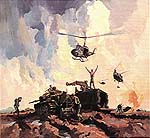Recovery in The Field - 1944

Page 5
Job 4

Of course when operating in boggy country it is not uncommon for the breakdown lorry to become bogged down itself and here it has to employ its own equipment for extraction.
For instance, in Fig. 23 we see one of the 3 ton breakdown vehicles in a quagmire nearly up to its axles. When this occurs the winch rope is changed from the rear to the front of the lorry, passed, as indicated in the photograph, through the two guide pulleys provided, and the end taken to firm ground where it is secured by a holdfast.
When we took the photograph the vehicle had no difficulty in winching itself out by this method.
Job5 .. Recovery without Tackle

A type of quick recovery involving the use of no tackle is that instanced in Fig24 in which a D8 caterpillar tractor is employed to recover a 15/20ton Covenanter tank from a bog.
The tractor is a standard commercial fully tracked vehicle of American origin with the addition of power winch gear and on reasonably good ground has a maximum winch pull, without anchoring, of 10 to 12ton.
Here, the rolling and grade resistance give an estimated pull of 9 tons, so backing up to the casualty, the winch rope is secured to the vehicle, the tractor runs out to firm ground, and the recovery is quickly accomplished.
Just as the men were coupling up, they were surprised by an tear gas attack; being always on the alert, gas masks were immediately donned and the recovery proceeded without hitch. The presence of the gas will be seen in the illustration.
Owing to its low maximum speed and general unsuitability for road work the tractor is carried to within close proximity of the casualty on an 8-wheeled 20 ton Dyson trailer towed by another tractor. An example of this transportation will be seen in our Middle East series of photographs presently.
Job6 .. Using D8 Cat


A further example of the use of a caterpillar tractor for extracting a Covenanter tank from a deep bog is given in Figs25 and 26.
In the first illustration the men have just finished coupling the 'A' vehicle tow rope to the casualty (which is well bogged down) and the winch rope.
The second photograph shows the tank emerging from the mud, the tractor having proceeded to a point where it not only has firm ground, but can take advantage of natural camouflage.
Hand Signalling
The latter illustration shows a good example of the use of correct hand signals to pass instructions to the driver of the recovery vehicle.
The Squad Commander alone gives orders, and places one man close to the breakdown vehicle so that he can transmit orders without the driver turning his head, thus enabling the driver to concentrate his whole attention on the job. Placing a second man in an intermediate position, the Commander takes his stand by the casualty and instructs as follows:
- Raising the right hand above his head means 'ready'.
- A rotation of the same hand says 'pull' (winch in).
- 'Stop' is given by throwing both hands above the head.
- Waving the hand up and down from the horizontal means 'slack back'.
These signals are simple and very effective; no word of mouth passes, and accidents to both breakdown vehicle and casualty are avoided.


